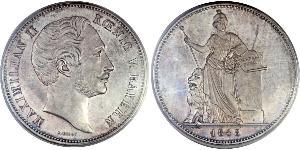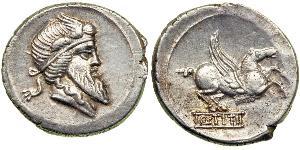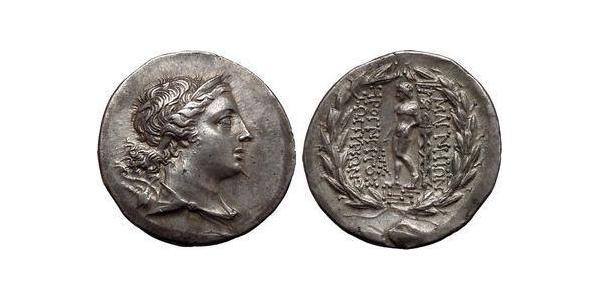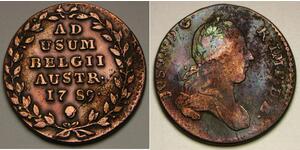[ 5496] IONIA: MAGNESIA AD MAEANDRUM Silver Tetradrachm, Stephanophoric type (33mm,16.70 gm.) Magnesia ad Maeandrum , 190 B.C. Reference: Jones 8-25; SNG Lewis 930. BMC 38. N.F.Jones, ANS MN 24 27a. Herognetos, son of Zopyrionos “magistrate”. Diademed and draped bust of Artemis right, bow and quiver over shoulder. Apollo Delphios standing left, left elbow resting on tall tripod behind, holding in right hand a branch tied with fillet; meander pattern below; all within laurel wreath, HPOΓNHTOΣ ZOΠYPIΩNOΣ to left, MAΓNHTΩN to right. Situated south-east of Ephesus, on a tributary of the Maeander, Magnesia was originally founded from Thessaly but was re-established by colonists from Miletos in the 7th century B.C. Provided with certificate of authenticity. CERTIFIED AUTHENTIC by Sergey Nechayev, PhD - Numismatic Expert Magnesia (Greek: Μαγνησία, Magnisía, IPA: [maɣniˈsia]), deriving from the tribe name Magnetes, is the name of the southeastern area of Thessaly in central Greece. The modern prefecture (Νομός Μαγνησίας) was created in 1947 out of the Larissa prefecture. About 70% of the population live in the Greater Volos area which is the second-largest city in Thessaly and the third busiest commercial port in Greece. Much of the population lives near the Pagasetic Gulf and in the eastern part. The chemical element, Magnesium, was named after the "City of Magnesia" by Sir Humphrey Davy in 1808[citation needed]The capital of Magnesia prefecture is the metropolitan city of Volos. According to the most recent census (2001), the population stands at 207,000. The prefecture of Magnesia includes the Northern Sporades group of islands (Skiathos, Skopelos and Alonissos. The prefecture also includes the Alonissos Marine Park. The prefecture hosts 2,000,000 tourists annually. Magnesia is represented in the Greek Parliament by five members. Geography The natural landscape of Magnesia consists of wooded mountains, cultivated flat land, and coastline. One of the area's main elements is the Pelion mountain range which is located the eastern region of the Prefecture and forms the eastern edge of the Pagasetic Gulf. The ranges' highest peak is Pourianos Stavros or Xeforti, (altitude 1624 metres). On the edge of Magnesia peninsula Tiseo mountain is found, which is considered to be the Southeast edge of Pelion. Mt. Maurovouni (1054 metres) is the northeastly most mountain of the prefecture and extends to the neighboring prefecture of Larissa. The southwest border of the prefecture is Mt.Othry, with its highest peak called Gerakovouni (1726 metres) and forms the boundary with the prefecture of Phthiotis. The interior of Magnesia has two plains. One found between Mt. Halkodonio (725 metres) and Othry is called Almyros plain, while the other between Halkodonio and Pelion is called the Volos-Velestino plain. The hydrological network of the prefecture is not particularly rich and is characterized by the absence of big rivers. The waters coming from Pelion shape the rivers Anavros, Platanorema, and Xirias. In the North section of the prefecture Lake Karla was formerly found. Lake Karla was drained in 1962, but attempts have been made for its partial restoration. On the bight of Sourpi, next to Amaliapolis a coastal wetland is found, with various species of migratory birds. This wetland together with the forest of Kouri - an infrequent lowland of Oak tree forest close to Almyros - is included in the list of the protected regions of the European Network Natura 2000. The Pagasetic Gulf dominates the interior coastline of Magnesia. Climate The average temperature is 17 degrees Celsius and the average rainfall about 540 millimetres per year. Heat waves and intense cold periods are rare. During the summer the temperature rises up to about 37 to 38 °C in August. The climate varies in different parts of the prefecture; close to the Pagasetic Gulf conditions are humid, in Nea Ionia it is quite dry and in Velestino and Almy ...
Mehr...

|
Beigetragen von:
anonymous 2015-08-18 |
Similar Coin Groups

2 Thaler Königreich Bayern (1806 - 1918) ...
Diese Gruppe hat 14 Münzen / 13 Preise
Add coin to this group

10 Mark Deutsche Demokratische Republik ...
Diese Gruppe hat 9 Münzen / 9 Preise
Add coin to this group

1 Denarius Römische Republik (509BC-27BC ...
Diese Gruppe hat 7 Münzen / 5 Preise
Add coin to this group

1/2 Thaler Kurfürstentum Bayern (1623 - ...
Diese Gruppe hat 5 Münzen / 4 Preise
Add coin to this group

1 Thaler Königreich Bayern (1806 - 1918) ...
Diese Gruppe hat 6 Münzen / 3 Preise
Add coin to this group

1 Peso República de Guatemala (1838 - ) ...
Diese Gruppe hat 7 Münzen / 6 Preise
Add coin to this group

1 Tetradrachm Artaxiad dynasty (190BC - ...
Diese Gruppe hat 56 Münzen / 3 Preise
Add coin to this group
2025-05-23
- Historical Coin Prices
2025-05-25
- New coin is added to 2 Liard Austrian Netherlands (1713-1795) Kupfer
2 Liard Austrian Netherlands (1713-1795) Kupfer
Diese Gruppe hat 4 Münzen / 4 Preise
⇑
AUSTRIAN NETHERLANDS 2 Liards 1789 - Copper - Joseph II. - VF+ - 1375 *
Das könnte Sie auch interessieren:








-300-150-N7QKX9ISGfEAAAFX9awaL_VH.jpg)






